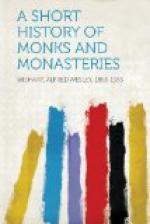Such are some of the effects of the monastic institution. Its history is at once a warning and an inspiration. Its dreamy asceticism, its gloomy cells, are gone. Its unworldly motives, its stern allegiance to duty, its protest against self-indulgence, its courage and sincerity, will ever constitute the potent energy of true religion. Its ministrations to the broken-hearted, and its loving care of the poor, must ever remain as a shining example of practical Christianity. In the simplicity of the monk’s life, in the idea of “brotherhood,” in the common life for common ends, a Christian democracy will always find food for reflection. As the social experiments of modern times reveal the hidden laws of social and religious progress, it will be found that in spite of its glaring deficiencies, monasticism was a magnificent attempt to realize the ideal of Christ in individual and social life. As such it merits neither ridicule nor obloquy. It was a heroic struggle with inveterate ignorance and sin, the history of which flashes many a welcome light upon the problems of modern democracy and religion.
Monastic forms and vows may pass away with other systems that will have their day, but its fervor of faith, and its warfare against human passion and human greed, its child-like love of the heavenly kingdom will never die. The revolt against its superstitions and excesses is justifiable only in a society that seeks to actualize its underlying religious ideal of personal purity and social service.
APPENDIX
NOTE A
The derivation and meaning of a few monastic terms may be of interest to the reader.
Abbot, from [Greek: abba], literally, father. A title originally given to any monk, but afterwards restricted to the head or superior of a monastery.
Anchoret, anchorite, from the Greek, [Greek: anachoretes], a recluse, literally, one retired. In the classification of religious ascetics, the anchorets were those who were most excessive in their austerities, not only choosing solitude but subjecting themselves to the greatest privations.
Ascetic, [Greek: asketes], one who exercises, an athlete. The term was first applied to those practicing self-denial for athletic purposes. In its ecclesiastical sense, it denotes those who seek holiness through self-mortification.
Canon Regular. About A.D. 755, Chrodegangus, Bishop of Metz, gave a cloister-life law to his clergy, who came to be called canons, from [Greek: kanon], rule. The canons were originally priests living in a community like monks, and acting as assistants to the bishops. They gradually formed separate and independent bodies. Benedict XII. (1399) tried to secure a general adoption of the rule of Augustine for these canons, which gave rise to the distinction between canons regular (i.e., those who follow that rule), and canons secular (those who do not).




